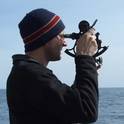Near-bottom seafloor mapping with precisely navigated deep submergence vehicles has become increasingly common in a range of oceanographic settings. Recent mapping efforts at deep-water hydrothermal vent sites have resulted in high-resolution (sub-meter) bathymetry datasets that can be used to identify morphological features associated with volcanic, tectonic, and hydrothermal processes. The resolution of these maps, and our ability to accurately quantify the complex morphologic details of hydrothermal structures has been limited by a number of variables including navigational accuracy, sonar settings (e.g. acoustic wavelength, sonar orientation, ping rate), survey parameters (e.g. altitude, speed), data density, and data processing techniques (e.g. gridding algorithms). We present the results of two near-bottom surveys conducted in August 2006 at the PACMANUS (Papua New Guinea-Australia-Canada Manus) hydrothermal field in the eastern Manus Basin of the Bismarck Sea, south of New Ireland, Papua New Guinea. Data were simultaneously acquired with two high-resolution multibeam sonar systems mounted on the Remote Operated Vehicle (ROV) Jason 2. A Simrad SM2000 (200 kHz) multibeam system was mounted in down-looking mode, and an Imagenex DeltaT (675 kHz) multibeam system was mounted on the brow of the vehicle in a forward-looking orientation. Surveys were conducted in parallel survey lines at 15 m altitude (15 m line spacing), and the can be used to generate sub-meter resolution maps of the seafloor. The maps were assembled using a terrain registration algorithm designed to minimize the affects of navigation error. Together, these sonars provide a complementary dataset that allows us to better quantify the 3-dimensional morphological characteristics of complex hydrothermal vent structures. This information can be used to more accurately estimate the volume of hydrothermal deposits, and render a more complete environmental picture that is less hindered by occlusions and poor sonar coverage in highly complex terrain.
AGU session number OS33A-1680.
